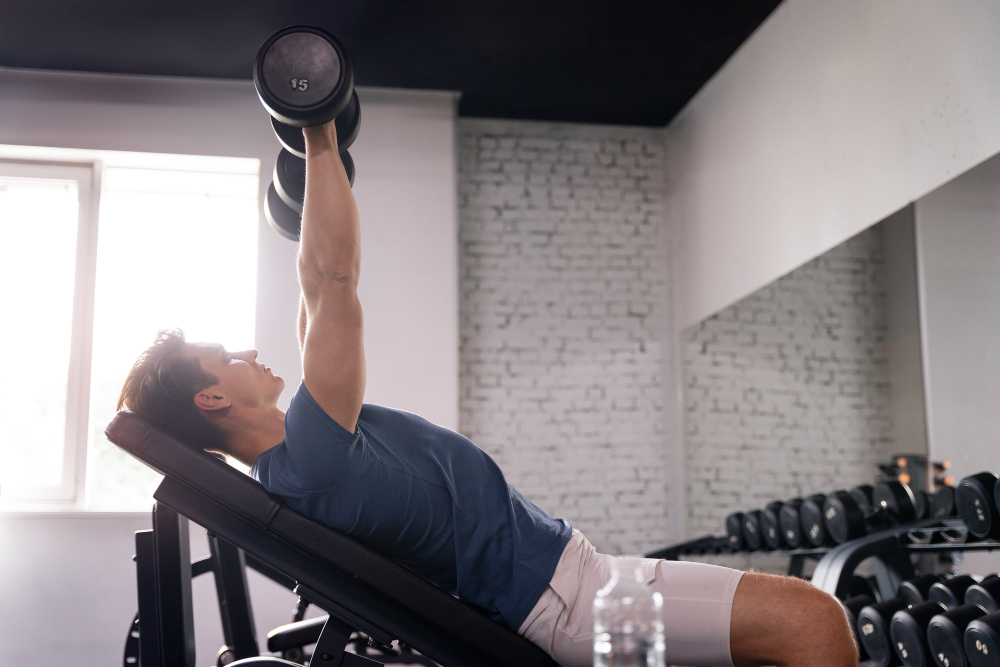Compound exercises involve multiple muscle groups, while isolation exercises target a specific muscle. Compound = more efficient, isolation = targeted.
TL;DR Compound exercises Vs. Isolation exercises
Compound exercises involve multiple muscle groups and joints working together, making them efficient for building overall strength and functional movements. Isolation exercises target specific muscles, allowing you to focus on strengthening individual areas.
What are compound exercises?

Compound exercises are multi-joint movements that engage multiple muscle groups simultaneously. These exercises require coordination and stability, as they involve more than one joint and muscle group working together to perform the movement.
Compound exercises involve complex movements that recruit several muscles at once.
What are isolation exercises?

Isolation exercises, as the name suggests, are exercises that target a specific muscle or muscle group. These exercises focus on isolating and working out one particular area of the body at a time.
Isolation exercises typically involve only a single joint movement.
The main goal of isolation exercises is to isolate and strengthen specific muscles in order to improve their size, shape, or definition. These exercises are often used by bodybuilders or individuals who want to target certain areas for aesthetic purposes.
Compound exercises Vs. Isolation exercises – Key differences
| Aspect | Compound Exercises | Isolation Exercises |
|---|---|---|
| Definition | Work multiple muscle groups simultaneously | Focus on a single muscle group |
| Muscle Involvement | Engage primary and secondary muscles | Target only the specific muscle being used |
| Efficiency | More efficient, as it works multiple muscles in one movement | Less efficient, as each exercise targets only one muscle |
| Functional Benefits | Mimic real-life movements, enhancing overall strength and coordination | Useful for targeting specific weaknesses or muscle imbalances |
| Examples | Squats, Deadlifts, Bench Press | Bicep Curls, Leg Extensions, Tricep Pushdowns |
| Training Level | Suitable for both beginners and advanced | Often preferred by bodybuilders and rehab patients |
| Time Efficiency | Require less time for a full-body workout | May require more time to work multiple muscles |
Benefits of compound exercises
- Efficiency: Compound exercises work multiple muscle groups at once, saving time and enabling a full-body workout in a shorter duration.
- Strength and Muscle Building: They stimulate the growth of various muscle groups simultaneously, leading to overall strength gains and muscle development.
- Functional Movements: Compound exercises mimic real-life movements, improving functional strength and coordination for everyday activities and sports.
- Increased Caloric Burn: Due to the involvement of multiple muscles, compound exercises burn more calories compared to isolation exercises.
- Hormonal Response: Compound exercises trigger a greater release of hormones like testosterone and growth hormone, promoting muscle growth and fat loss.
- Core Stabilization: Many compound exercises engage the core muscles, enhancing stability and reducing the risk of injuries.
- Improved Athletic Performance: By enhancing overall strength and coordination, compound exercises can improve performance in various sports and physical activities.
- Time-Efficient Workouts: For individuals with limited time for exercise, compound exercises provide an effective way to achieve a well-rounded workout.
- Versatility: Compound exercises can be performed using various equipment or bodyweight, making them accessible for different fitness levels and settings.
- Muscle Balance: These exercises promote balanced muscle development, reducing the risk of muscle imbalances and related injuries.
Compound exercises are a cornerstone of strength training and fitness programs, offering numerous advantages for individuals seeking efficient, effective, and functional workouts.
Benefits of Isolation exercises
- Targeted Muscle Development: Isolation exercises focus on specific muscles, allowing individuals to address weaknesses or imbalances in their physique.
- Muscle Definition: By isolating specific muscles, these exercises can enhance muscle definition and shape in particular areas of the body.
- Injury Rehabilitation: Isolation exercises are commonly used in physical therapy to rehabilitate injured muscles or joints without putting excessive strain on other areas.
- Precision and Control: These exercises require focused muscle engagement, helping individuals develop better mind-muscle connection and control.
- Pre-exhaustion Technique: Isolation exercises can be used to “pre-exhaust” a target muscle before performing compound exercises, effectively targeting it during compound movements.
- Supplemental Training: They serve as supplementary exercises to compound movements, providing a well-rounded workout routine.
- Time Under Tension: Isolation exercises often involve slow and controlled movements, increasing the time under tension on the targeted muscle, which can aid in muscle growth.
- Aesthetic Focus: Bodybuilders often incorporate isolation exercises to emphasize specific muscle groups and create a balanced and aesthetically pleasing physique.
- Joint-Friendly: Some isolation exercises are less taxing on joints, making them suitable for individuals with joint issues or mobility limitations.
- Variety and Personalization: Incorporating isolation exercises allows individuals to customize their workouts based on their specific fitness goals and preferences.
The effectiveness of isolation exercises lies in combining them with compound movements for a well-rounded and comprehensive strength training program.
Examples of compound exercises and isolation exercises?
Compound Exercises
- Squats: Engages multiple lower body muscles, including quadriceps, hamstrings, glutes, and core.
- Deadlifts: Works the entire posterior chain, including hamstrings, glutes, lower back, and traps.
- Bench Press: Targets chest, shoulders, and triceps, while also engaging stabilizing muscles.
- Pull-Ups/Chin-Ups: Work the back, biceps, and shoulders, along with core stabilization.
Lunges: Engage quadriceps, hamstrings, glutes, and stabilizing muscles in the legs and core.
Isolation Exercises
- Bicep Curls: Isolate and target the biceps muscles in the arms.
- Tricep Extensions: Focus on the triceps muscles on the back of the arms.
- Leg Extensions: Isolate the quadriceps muscles on the front of the thighs.
- Dumbbell Flyes: Target the pectoral muscles in the chest.
- Lateral Raises: Work the lateral deltoids, the side muscles of the shoulders.
Image Credits
Featured Image By – Sketchepedia
Image 1 By – Drazen Zigic on Freepik
Image 2 By – Image by Freepik









